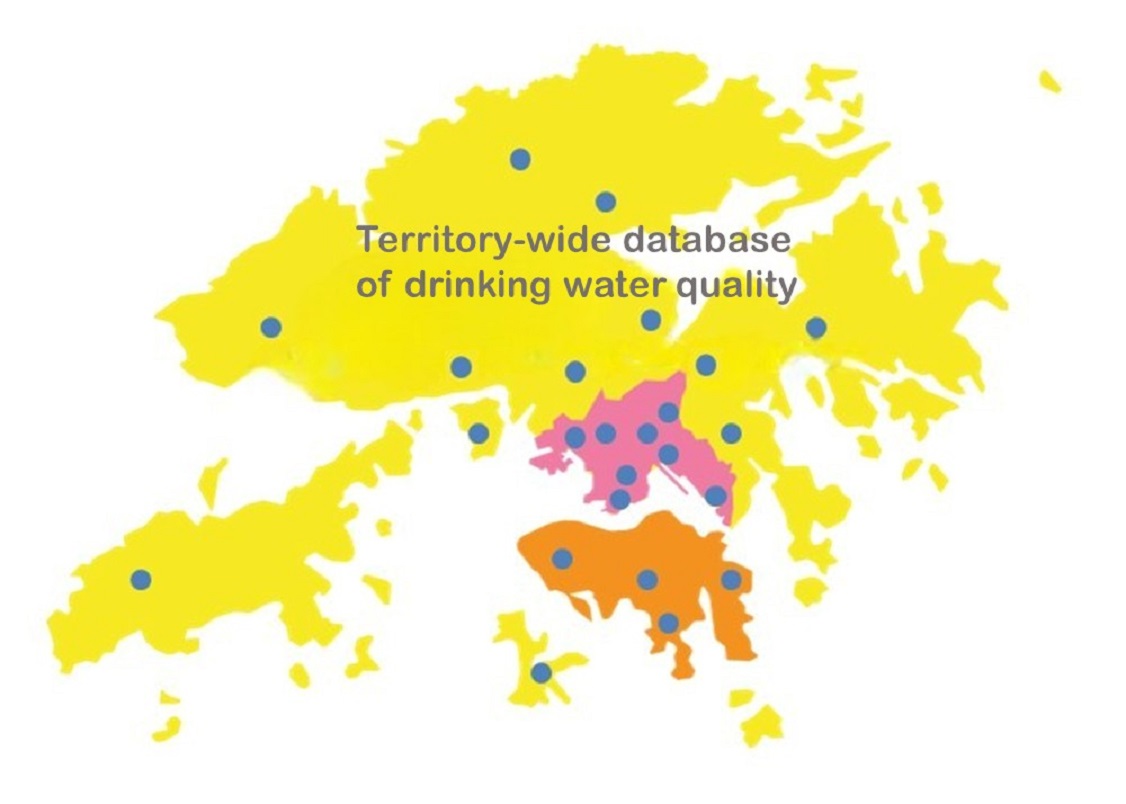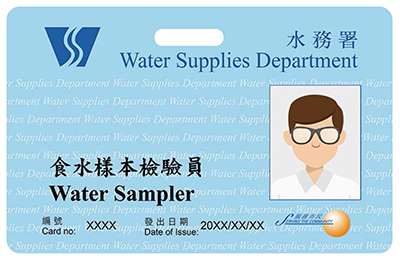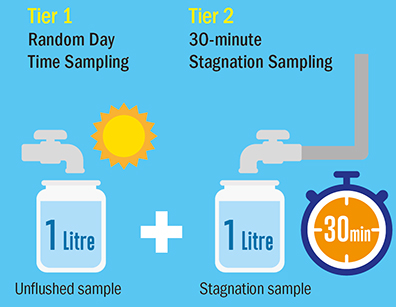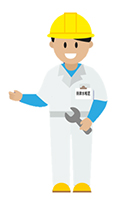The Water Supplies Department (“WSD”) used to supply drinking water in accordance with the World Health Organization’s Guidelines for Drinking-water Quality (“WHO Guidelines”). Based on the review of expert consultant on the approaches, rationales and practices in establishing drinking water standards of two international organizations (i.e. the World Health Organization (“WHO”) and the European Union) and seven overseas countries (i.e. the United Kingdom, the United States of America, Canada, Australia, Singapore, New Zealand and Japan), the Government of the Hong Kong Special Administrative Region (“the Government”) has established the HKDWS which have been agreed by the Drinking Water Safety Advisory Committee 1 (“DWSAC”).
Note:
1 DWSAC comprises experts from relevant sectors, including academics and medical experts, and will give advice to the Development Bureau on water safety issues in Hong Kong.
Over the years, the WSD has been supplying drinking water in full compliance with the WHO Guidelines and the subsequent HKDWS. The WSD has implemented a drinking water quality monitoring programme by collecting drinking water samples from water treatment works, service reservoirs, connection points and publicly accessible consumers’ taps (such as those in shopping centres, clinics, community facilities, sports grounds, markets, government offices and estate management offices) to monitor the quality of drinking water as supplied to consumers. The WSD has extended the drinking water quality monitoring to consumers’ taps by implementing the Enhanced Programme in December 2017. At present, the WSD will collect drinking water samples at consumers’ taps in randomly selected premises for testing five metals that could be present in internal plumbing systems, residual chlorine and Escherichia coli (“E.coli ”).
The possible sources and risk of contamination of the five metals, excessive residual chlorine and E.coli in internal plumbing systems are tabulated below:-
| Parameter | Possible Sources | Risk of Contamination |
|---|---|---|
| Cadmium (Cd) HKDWS ≤ 3 µg/L |
|
|
| Chromium (Cr) HKDWS ≤ 50 µg/L |
|
|
| Copper (Cu) HKDWS ≤ 2000 µg/L |
|
|
| Lead (Pb) HKDWS ≤ 10 µg/L |
|
|
| Nickel (Ni) HKDWS ≤ 70 µg/L |
|
|
|
Residual Chlorine HKDWS ≤ 5 mg/L |
|
|
|
E.coli HKDWS = 0 cfu/100 mL |
|
|

The Enhanced Programme monitors the quality of drinking water at consumers’ taps in Hong Kong. Participating premises are randomly selected from all water accounts using a random sample selection methodology. The selection process is administered by an independent consultant commissioned by the WSD. The Registered Consumer (“RC”) and occupier of the selected premises will receive invitation letters from the WSD. The property management agent, if any, will also be informed of the sampling visit to the building.
To ensure sufficient drinking water samples are collected under the Enhanced Programme, the WSD will issue invitation letters to more premises than the target number of drinking water samples required2. Thus, the WSD will not collect drinking water samples from all the premises that have received the invitation letters. The WSD will send a sampling team for each visit comprising a water sampler of the WSD and a licensed plumber appointed by the consultant. A sampling period will be stated in the invitation letter and will usually start two weeks after the date of issue of the invitation letter.
Note:
2 It is to cater for unsuccessful entry to some of the invited premises (e.g. the door is not answered) for collection of drinking water samples.
Participation in the Enhanced Programme is by invitation only and non-mandatory. Nevertheless, participation in the programme is encouraged as it will greatly help the WSD monitor drinking water quality in the district where the premises is located, which will also enable the creation of a territory-wide database of drinking water quality for reviewing the HKDWS in respect of the relevant parameters.

The sampling team will visit the premises during daytime (i.e. from 9:00am to 5:00pm) from Monday to Friday (except holidays). The sampling staff will wear uniforms and staff cards for identification.

Sample Staff Card of WSD's Water Sampler
If consent is obtained from the occupier of the premises during the visit, the sampling staff will collect drinking water samples from any one of the kitchen water taps or any water tap used for potable purpose on the premises. The sampling process will take about one hour.
Two-Tier Sampling Protocol for Five Metals:
A two-tier sampling protocol is adopted for testing the five metals at consumers’ taps under the Enhanced Programme:

During collection of the above two-tier samples, the sampling staff will also collect auxiliary samples which will only be tested to provide supplementary information if exceedance is found in the two-tier samples. A number of 1-litre sequential samples at the water tap (generally 2 to 6 samples) will be collected for assessing whether the problem is confined to the premises or not, while a 2-minute flushed sample will be collected to confirm applicability of flushing advice as a mitigation measure in case of exceedance.
Sampling Protocols for Residual Chlorine and E.coli
After collecting the above samples for testing the five metals, the water tap will be flushed for at least 2 minutes and drinking water will be collected at the water tap for testing residual chlorine. The water tap will then be disinfected and further flushed for at least 2 minutes and a 250 mL drinking water sample will be collected at the water tap for testing E.coli.
Note:
3 The mean exposure levels of the five metals of the consumer in Hong Kong through drinking water on a regular basis.
4 To verify that the exceedance in the Tier 1 sample is not caused by unduly long stagnation (e.g. a water tap that has not been used for a long time due to long vacation or other reason) or sporadic presence of metal particles.
If no exceedance is found in the Tier 1 or Tier 2 sample5 for testing the metals, residual chlorine or E.coli, the WSD will notify the RC by mail and occupier (and when necessary the owner as far as practicable) of the concerned premises and (if necessary) the relevant party responsible for maintaining and managing the building (such as property management agents, owners’ association as appropriate, if applicable) by hand as soon as possible, and in some cases the relevant Government bureaux and departments, the relevant licensing authorities and other relevant parties of the test result, and request them to notify other water consumers in the building of the exceedance.
If exceedance is found in the drinking water sample for testing the metals6, residual chlorine or E.coli, the WSD will notify as soon as possible the occupier (by hand), the RC, the owner and the relevant party responsible for maintaining and managing the building (such as property management agents, owners’ association as appropriate, if applicable).
Note:
5 If exceedance is found in the Tier 1 sample but not in the Tier 2 sample for testing the metal(s), this will indicate that the exceedance of the Tier 1 sample is likely due to unduly long stagnation time before sampling or sporadic presence of metal particles, and again no further action is required.
6 Exceedance in both Tier 1 and Tier 2 samples for testing metal(s).
If there is exceedance in the drinking water samples for testing metal(s), it suggests possible metal contamination of the drinking water in the internal plumbing system of the concerned premises. The WSD will:
| i) |
provide information on the related health risks. For details, please refer to the pamphlets “What you need to know about Lead in Drinking Water on health?” and “What you need to know about antimony, cadmium, chromium, copper and nickel in drinking water on health?” published by the Department of Health; |
| ii) |
advise on possible mitigation measures as follow:
|
| iii) |
provide technical information such as possible source of the exceedance and options to deal with the problem including the engagement of designated person(s) (e.g. licensed plumbers) to rectify the internal plumbing system; and |
| iv) |
offer the RC a one-off free investigation into the cause and location of exceedance. Alternatively, the RC can choose to engage a qualified consultant/person (i.e. building services engineer, building surveyor or licensed plumber who has been included in the list of qualified consultants/persons providing investigation services) for conducting the investigation work. A list of qualified consultants/persons providing investigation services is available at below: |
Renovation and/or routine maintenance of a premises may involve alteration of the plumbing installations (e.g. replacement of water taps or realignment of water pipes) and the use of non-compliant water pipes and fittings may give rise to metal exceedance in drinking water on the premises. In other words, metal exceedance of drinking water samples on one premises may either be a standalone case or there may be a possibility of similar exceedance on other premises in the same building.
If the WSD discovers that there is possibility of metal exceedance in drinking water also in other internal plumbing systems in the same building, it will notify the relevant party responsible for maintaining and managing the building (such as property management agents, owners’ associations as appropriate). They will be advised to carry out detailed investigations by engaging a qualified consultant/person to verify the problem of exceedance and to establish its extent in the building. The WSD will provide the relevant party with the necessary technical advice and recommendations as appropriate. The relevant party will also be advised to notify all the owners and occupiers in the building to make necessary arrangements to ensure that all consumers on their premises are aware of the problem and to implement the recommended mitigation measures until the extent of problem has been ascertained and rectified. A list of qualified consultants/persons providing investigation services is available at the WSD’s website as mentioned above.
The long term solution to metal exceedance in drinking water is to replace any non-compliant pipes and/or fittings in the concerned internal plumbing system. The concerned RC/party should engage designated person(s) (e.g. licensed plumbers) to carry out the rectification works.
If there is exceedance in the drinking water sample for testing residual chlorine or E.coli, it suggests possible chlorine or E.coli contamination of the drinking water in the internal plumbing system of the building. The WSD will:
| i) |
for exceedance of residual chlorine, the premises in the building should stop using the water from their water taps and use alternative water sources. The party responsible for maintaining and managing the building should arrange immediate flushing of the internal plumbing system and implement appropriate follow-up actions/mitigation measures as necessary in the building. Afterwards, all premises in the building should flush all their water taps for 2 minutes before using the water. Chlorine is the most commonly used disinfectant in drinking-water treatment. If you have experienced any irritation of mouth or throat, or have any health concerns after consumption of water with residual chlorine exceeding HKDWS, you may consult your family doctor. |
| ii) |
for exceedance of E.coli, the occupiers of the building should boil water from water taps before drinking, preparing drink or food, making ice, washing dishes, mouth rinsing and brushing teeth. They may also use alternative water sources. The relevant party responsible for maintaining and managing the building should arrange immediate disinfection of the internal plumbing system of the building up to each consumers’ tap and implement appropriate follow-up actions/mitigation measures as necessary. All premises in the building should flush all their water taps for 2 minutes after the disinfection before using the water. The presence of E.coli in drinking water is considered as an evidence of recent faecal contamination. If you have gastrointestinal symptoms such as abdominal cramps, diarrhoea or vomiting, or have any health concerns after consumption of water contaminated with E.coli, you may consult your family doctor. |

Moreover, the WSD will take further follow-up actions for certain types of premises in case of exceedance of the drinking water sample(s). For premises where drinking water is supplied for potable consumption either by the general public (e.g. restaurants) or, in case of lead exceedance, the more easily affected groups (e.g. kindergartens), the WSD will work with the RC and occupier of the premises with a view to implementing mitigation measures for stopping the contaminated water from being supplied for consumption by the general public/more easily affected groups, such as arranging alternative water sources as well as subsequent rectification of the internal plumbing system.
The WSD will undertake to follow up the progress of the mitigation measures/rectification works with the overriding public health interest in mind. Whilst the respective RC, occupier or relevant party responsible for maintaining and managing the building will normally take cooperative action to carry out the necessary mitigation measures and/or rectification works, in case there is no effective mitigation measures and/or rectification works being carried out resulting in public health being jeopardised, the WSD will consider taking further actions including appropriate enforcement action in order to protect the public health.
The test results of the drinking water samples collected from individual premises will be used in the compilation of the water quality statistics for publication on the WSD’s website. The water quality statistics for the five metals, residual chlorine and E.coli will be published every week.
The information collected under the Enhanced Programme
| i) |
will be used for the purposes of the Enhanced Programme and the general administration of the Waterworks Ordinance and the Waterworks Regulations and any other purposes directly related thereto; and |
| ii) |
may be transferred to other Government bureaux and departments, relevant licensing authorities, party responsible for maintaining and managing the building in which the premises participating in the Enhanced Programme is located (including but not limited to property management agent and owners' association) and any other relevant parties for the purposes set out in (i) above. |
The WSD will NOT reveal the full address of the premises participating in the Enhanced Programme and the identities of the RC, the occupier and the property owner unless consent is obtained from them or when general public health is at risk as revealed by the test result.
If you have any enquiry about the Enhanced Programme, you may call the hotline for the Action Plan for Enhancing Drinking Water Safety in Hong Kong:
Note:
7 For calls received outside the service hours, they would be picked up by our Customer Service Officers and the details would be recorded. The concerned enquiries would be replied by our operators during the service hours.
For more information on health aspects concerning the five metals, please visit website of the Department of Health’s Centre for Health Protection.
Please visit the Enhanced Water Quality Monitoring Programme - Weekly Monitoring Data at Consumers' Taps for more details.
Please visit the Enhanced Water Quality Monitoring Programme - Annual Summary of Water Quality Statistics in 2024 for details.